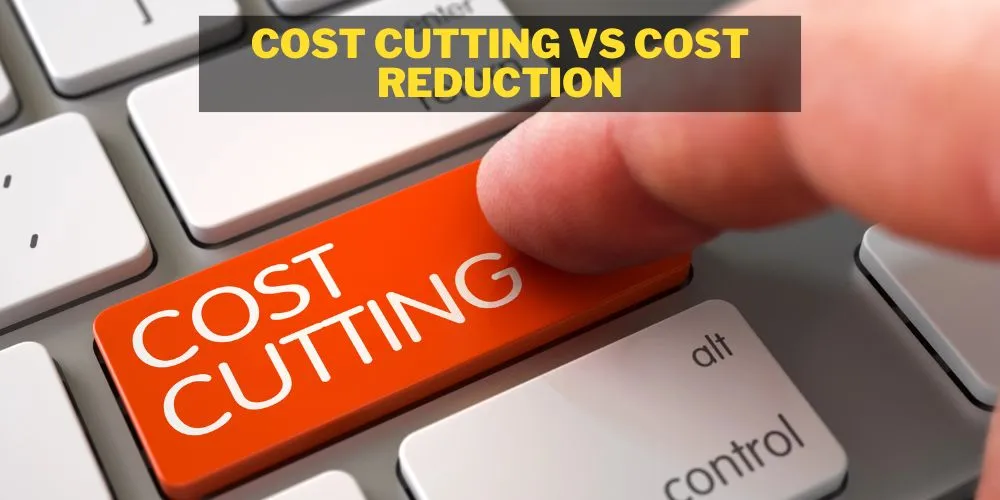In today’s competitive business landscape, companies constantly look for strategies to improve their efficiency and reduce operational costs. Two common approaches to achieving these objectives are cost cutting and cost reduction.
While these terms are often used interchangeably, they represent distinct concepts with unique impacts on a business’s long-term success.
This cost cutting vs cost reduction article seeks to explore the differences between cost cutting and cost reduction, their advantages, and how businesses can implement these strategies effectively.
Understanding the Basics
What is Cost Cutting?
Cost cutting involves reducing expenses in the short term, typically as a reaction to financial stress or the need to improve immediate financial performance. This method focuses on cutting down expenses in a way that doesn’t necessarily consider the long-term impact on the company’s operational capacity.
Common cost-cutting measures include reducing staff numbers, downsizing office space, and limiting business-related travel.
While cost cutting can provide quick financial relief, it may also result in reduced service quality or employee morale over time.
What is Cost Reduction?
Cost reduction, on the other hand, is a strategic, long-term approach aimed at improving a company’s efficiency by reducing expenses without sacrificing the quality of products or services.

This method focuses on process optimization and efficiency improvement, such as automating manual tasks, enhancing supply chain logistics, and renegotiating contracts for better rates.
Unlike cost cutting, cost reduction aims to strengthen the business by making it leaner and more agile, setting the stage for sustainable growth and competitiveness.
Cost Cutting vs Cost Reduction: An Honest Comparison
The Objective Comparison
The primary difference between cost cutting and cost reduction lies in their objectives. Cost cutting is about reducing spending quickly to improve a company’s financial standing in the short term.
It often involves making hard decisions like layoffs or reducing product quality.
In contrast, cost reduction seeks to lower costs through efficiency and productivity improvements, focusing on long-term benefits without compromising the business’s core values or product quality.
Short-term Gains vs. Long-term Benefits
Short-term gains from cost cutting might be appealing, especially in times of financial crisis.
However, the potential damage to a company’s infrastructure and employee morale can outweigh these benefits, leading to decreased productivity and customer satisfaction.
Cost reduction allows for more sustainable growth by cutting costs through efficiency, which can continuously improve the business’s bottom line without negative side effects.
Implementing Strategies in Business
When to Use Cost Cutting
There are appropriate times to use cost cutting, such as during severe financial hardships when immediate action is necessary to keep the business afloat.
In such cases, management must carefully consider which cuts will have the least detrimental effects on the company’s long-term growth and employee well-being.
When to Implement Cost Reduction
Cost reduction should be part of a business’s ongoing strategy. It’s most effective when implemented in a stable financial environment where the focus can be on innovation and process improvement rather than emergency financial recovery.
This approach encourages a culture of efficiency and continuous improvement, positioning businesses to respond more flexibly to future challenges.
Tools and Techniques
Tools for Effective Cost Cutting
Various tools and software can support cost-cutting initiatives by providing insights into where a company can trim expenses without significant disruptions.
Budgeting software and expense tracking tools help identify and monitor unnecessary costs, enabling more informed decision-making.
Techniques for Achieving Cost Reduction
Methodologies such as Lean and Six Sigma are invaluable for businesses aiming to reduce costs through process improvements.

Lean focuses on eliminating waste within manufacturing processes, while Six Sigma aims at reducing variation and defects.
Additionally, technology plays a crucial role in cost reduction, with solutions like AI and data analytics offering new ways to enhance efficiency and reduce operational costs.
Impact on Organizational Health
Employee Morale and Operational Efficiency
The way a company approaches cost management can significantly impact employee morale and operational efficiency.
Cost cutting measures, particularly those involving layoffs, can lead to lower morale and trust in management, subsequently affecting productivity.
Conversely, a focus on cost reduction through efficiency can foster a positive work environment, where employees are encouraged to contribute ideas for improvement, enhancing both morale and productivity.
Case Studies
Real-world case studies highlight the effectiveness of both strategies in different contexts. For example, a company facing immediate bankruptcy may need to implement rapid cost-cutting measures to survive.
Meanwhile, another company may achieve notable long-term growth through a comprehensive cost reduction strategy, focusing on process improvements and technological innovation.
Pro Tips
To effectively balance cost cutting and reduction, businesses should continually monitor their financial performance and the impact of cost management strategies on their overall health.
Involving employees in the process and remaining transparent about the reasons and expectations can help maintain morale and foster a culture of efficiency.
Frequently Asked Questions
How do I know if my business should focus more on cost cutting or cost reduction?
Deciding between cost cutting and cost reduction depends on your business’s immediate financial needs and long-term goals. In a crisis, cost cutting might be necessary, but for sustainable growth, focus on cost reduction.
Can cost cutting and cost reduction be implemented simultaneously?
Yes, but it requires careful planning to ensure cost-cutting measures do not undermine the long-term goals of cost reduction strategies.
What are the common pitfalls in cost cutting that businesses should avoid?
Avoid cutting costs blindly without considering the long-term impacts, especially cuts that affect product quality or employee morale.
How often should a business revise its cost management strategies?
Regularly reviewing and adjusting cost management strategies is vital, ideally as part of the annual budgeting process or more frequently if necessary.
Are there industries where cost reduction strategies might not be effective?
While some industries might have less flexibility for process changes, virtually every sector can benefit from a focus on efficiency and cost reduction at some level.
Conclusion
Both cost cutting and cost reduction play crucial roles in a business’s financial strategy.
Choosing the appropriate approach depends on the company’s current financial health, long-term goals, and the overall impact on the business’s operational capacity.
While cost cutting can provide quick financial relief, it’s essential to balance these measures with strategies for sustainable cost reduction.
By focusing on efficiency and continuous improvement, businesses can ensure their longevity and competitiveness in the market.


 Tags:
Tags:










